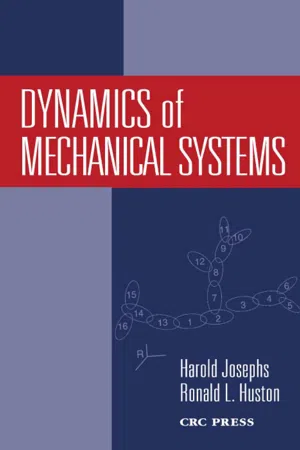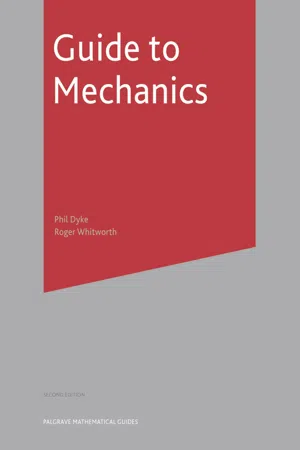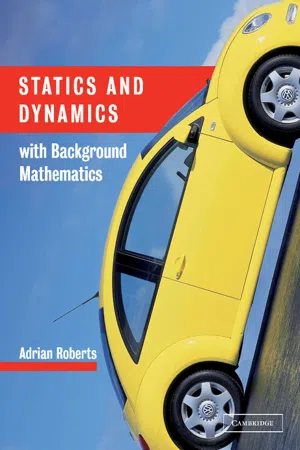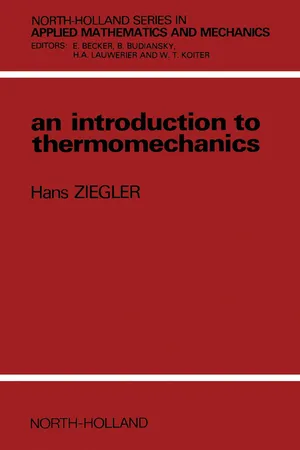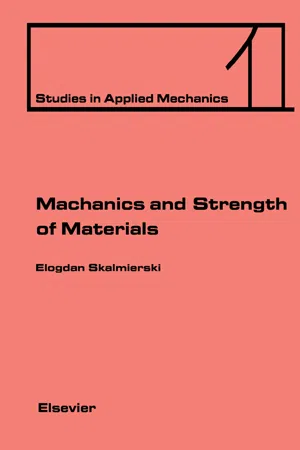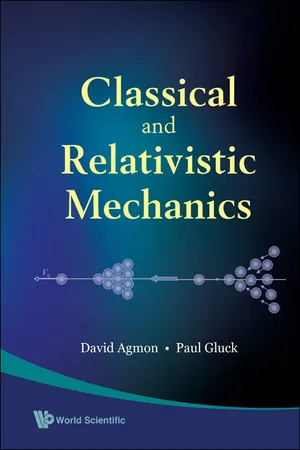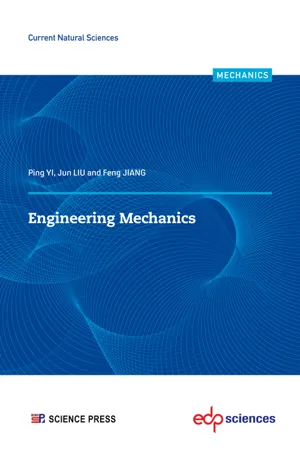Mathematics
Calculus Kinematics
Calculus kinematics involves using calculus to analyze the motion of objects. It focuses on concepts such as position, velocity, and acceleration, and uses derivatives and integrals to study the relationships between these quantities. By applying calculus to kinematics, it becomes possible to understand and predict the behavior of moving objects with greater precision and detail.
Written by Perlego with AI-assistance
Related key terms
1 of 5
12 Key excerpts on "Calculus Kinematics"
- eBook - PDF
- Harold Josephs, Ronald Huston(Authors)
- 2002(Publication Date)
- CRC Press(Publisher)
57 3 Kinematics of a Particle 3.1 Introduction Kinematics is a study of motion without regard to the cause of the motion. Often this motion occurs in three dimensions. For such cases, and even when the motion is restricted to two dimensions, it is convenient to describe the motion using vector quantities. Indeed, the principal kinematic quantities of position, velocity, and acceleration are vector quantities. In this chapter, we will study the kinematics of particles. We will think of a “particle” as an object that is sufficiently small that it can be identified by and represented by a point. Hence, we can study the kinematics of particles by studying the movement of points. In the next chapter, we will extend our study to rigid bodies and will think of a rigid body as being simply a collection of particles. We begin our study with a discussion of vector differentiation. 3.2 Vector Differentiation Consider a vector V whose characteristics (magnitude and direction) are dependent upon a parameter t (time). Let the functional dependence of V on t be expressed as: (3.2.1) Then, as with scalar functions, the derivative of V with respect to t is defined as: (3.2.2) The manner in which V depends upon t depends in turn upon the reference frame in which V is observed. For example, if V is fixed in a reference frame ˆ R, then in ˆ R, V is independent of t . If, however, ˆ R moves relative to a second reference frame, R, then in R V depends upon t (time). Hence, even though the rate of change of V relative to an observer in ˆ R is zero, the rate of change of V relative to an observer in R is not necessarily zero. Therefore, in general, the derivative of a vector function will depend upon the reference frame in which that derivative is calculated. Hence, to avoid ambiguity, a super-script is usually added to the derivative symbol to designate the reference frame in which V V = ( ) t d dt t t t t t V V V = + ( ) − ( ) → D Lim ∆ ∆ ∆ 0 - eBook - PDF
- David F. Rogers(Author)
- 2016(Publication Date)
- Pergamon(Publisher)
The subject of kinematics provides a good example. Between 1940 and 1960 the availability of drafting tables and good drawing instruments promoted the development of graphical solution techniques for obtaining the displacement, velocity, and acceleration of mechanical com-ponents. Many of these techniques are still in use today [1]. The scientific and mathematical emphasis during the past 20 years has resulted in a vector analysis approach to kinematic analysis in most engineering curricula [2]. Both the graphical and vector analysis methods lead to the determination of instantaneous kinematic values for a particular configuration of the device under study. They will continue to provide valuable design tools for the engineer. Computer graphics makes feasible the use of complete kinematic motion curves for describing the behavior of mechanical components. This provides the option of observing the behavior of a mechan-ism over a complete cycle of operation, rather than at only a few instantaneous positions. The generation of motion curves may require a change in the manner in which the fundamental subject of kinematics is presented to undergraduate engineering students. The purpose of this paper is to illustrate some of the new options available to educators in engineering and physics which are feasible using low cost computer graphics. K I N E M A T I C S Kinematics, the study of motion in terms of displacement, velocity, and acceleration is fundamental to understanding modern technology. All components of a device in motion are treated as rigid members, and no concern is given to the forces which cause the motion. Kinematics is the foundation for later study in dynamics, vibrations, and machine design where forces and deflections are con-sidered. As higher speeds are encountered and energy efficient designs become more critical, a com-plete description of kinematic behavior will often be needed for proper analysis. - eBook - PDF
- Philip Dyke, Roger Whitworth(Authors)
- 2017(Publication Date)
- Red Globe Press(Publisher)
CHAPTER 1 Kinematics 1.1 Introduction The study of the motion of bodies requires a structured understanding of the fundamental quantities of displacement and time. This study is called kine-matics and it will provide a basis for later modelling in other branches of mechanics. From time and displacement, we derive the quantities velocity and acceleration. Displacement, velocity and acceleration are vector quantities and can be expressed in an algebraic vector form. Not surprisingly, therefore, the study of vectors is crucial to the study of kinematics and indeed of all mechanics. We shall start our study by considering some kinematic quantities which may already be familiar. Everyday language provides us with an intuitive compre-hension of these quantities, but in some cases this familiarity can lead to serious misunderstanding, particularly where vectors are concerned. Here is an illustrative example. When a car is travelling along a road, and the speedometer reads an unchanging 30 km per hour, the driver naturally assumes that the speed is constant. The fact is that if the car is cornering, or going down or climbing up a hill, it is accelerating despite the constant speed shown on the speedometer. In the following section, we establish the concepts of displace-ment, velocity and acceleration. In particular, we clarify the distinction between speed and velocity, often used as synonyms by non-mathematicians, and the cause of the apparent contradiction of the accelerating car with its constant speedometer reading. 1.2 Definition of kinematic quantities Now we present formal definitions of displacement, distance, velocity, speed and acceleration which should help us to make a start in clearing up miscon-ceptions. Consider the fixed points P and Q , illustrated in Figure 1.1. The displacement from P to Q represented by the vector PQ ! s is the translation that is needed to move the point P to the point Q . - A. P. Roberts(Author)
- 2003(Publication Date)
- Cambridge University Press(Publisher)
Part II Dynamics 10 Kinematics of a point 10.1 Rectilinear motion Kinematics is concerned with motion in an abstract sense without reference to force or mass. We shall start by analysing motion in a straight line, i.e. rectilinear motion . Consider a point P moving along a straight line from O, as indicated in Figure 10.1. If it takes t seconds to travel x metres from O to P, then its average speed or velocity is x / t metres per second or x / t m/s or x / t m s − 1 . We have to insert the word ‘average’ because the velocity may not be constant over that period of time. If the velocity is varying, we need to be able to define it at any instant of time. To do this, we have to use calculus, which involves taking the average velocity over a short interval of time and then taking the limit as this interval tends to zero. Suppose our point P moves a distance δ x in time δ t . The velocity at the start of this interval is then: v = lim δ t → 0 δ x δ t = dx dt = ˙ x . dx / dt is called the derivative of x with respect to t and it is the rate at which x is changing at that instant. The dot notation (˙ x ) was introduced by Newton for the derivative with respect to time and it continues to be used as a shorthand notation. If the velocity v is varying, then v itself will have a rate of change and this rate is called the acceleration of P. Let the velocity v change by δv over a short interval of time δ t . Then the acceleration at the start of that interval is: lim δ t → 0 δv δ t = d v dt = ˙ v = d ˙ x dt = d 2 x dt 2 = ¨ x . Hence, we may regard the acceleration as being the first derivative with respect to time of the velocity, i.e. ˙ v , or the second derivative with respect to time of position, i.e. ¨ x . Note that two dots are used to denote the second derivative with respect to time. Although the derivative of velocity with respect to time is the most obvious way to define acceleration, there is another way that is sometimes useful.- eBook - PDF
- H. Ziegler(Author)
- 2012(Publication Date)
- North Holland(Publisher)
C H A P T E R 2 KINEMATICS Kinematics describes the motion of a n arbitrary b o d y with respect to a reference frame. It requires a time scale, which in classical mechanics is assumed to be the s a m e for all possible reference frames. In a purely kinematical description the forces responsible for the m o t i o n are disregarded. T h e m o t i o n is k n o w n as s o o n as the configuration of the b o d y is specified as a function of time. If the m o t i o n is k n o w n for an infinitesimal time interval [t, / + d / ] , i.e., if the instantaneous change of configuration is prescribed, we say t h a t we k n o w the state of motion at time t. In this chapter we will study these concepts for a c o n t i n u u m . 2 . 1 . The state of motion In c o n t i n u u m mechanics the atomistic structure of m a t t e r is disregarded a n d the b o d y is a s s u m e d t o occupy a certain region in space in a c o n t i n u o u s m a n n e r . This is justified for practical purposes as long as the b o d y contains a sufficiently large n u m b e r of a t o m s . W e will see, however, that for the explanation of certain p h e n o m e n a (crystal elasticity, t h e r m a l effects, etc.) the molecular structure has to be t a k e n , at least temporarily, into account. W e will not specify at present whether the continuum considered is a gas, a liquid, or a solid; in fact, these terms will not be defined until C h a p t e r 5. W e will a s s u m e , however, t h a t the b o d y is d e f o r m a b l e , in contrast to the rigid b o d y treated in elementary mechanics. Referring a c o n t i n u u m to a cartesian c o o r d i n a t e system, we distinguish between spatial points, fixed in the reference system, a n d material points or particles, considered to be elements of the c o n t i n u u m a n d thus taking part in its m o t i o n . In a similar m a n n e r we distinguish between spatial a n d material curves, surfaces a n d volumes. - eBook - PDF
- Bogdan Skalmierski(Author)
- 2013(Publication Date)
- Elsevier(Publisher)
CHAPTER 1 Kinematics The primary concepts in mechanics are space and time. Regarding space, we shall assume that it is Euclidean (plane), therefore an orthogonal frame of reference can be applied to it. Furthermore, it will be assumed that space is uniform and isotropic, i.e., there are no distinct loci nor preferred directions in it. With regard to time, it will be recognized as uniform, i.e., preferred instants are non-existent in it. Some parts of this book deal with problems within the purview of classical mechanics, therefore the following two hypotheses have been accepted: 1. Time is absolute, i.e. it runs identically in all frames of reference (moving and fixed). 2. The distance between two arbitrary points in space, irrespective of the frame of reference in which it is measured, is identical (it is an invariant). Kinematics is a science of motion but it is not concerned with the causes liable to induce or disturb motion. By motion we shall understand changes in time in the position of a body referred to a system treated as stationary. The position of a body or configuration is an area of Euclidean space, in which the particles of that body have been mapped one-to-one and continuously. This mapping we shall call homeomorphism. Accordingly, motion is the change of mapping in time. Note that the concept of motion is relative, since it depends on the adopted frame of reference. 1.1 Motion of a single particle We assume a right-handed frame of reference Oxyz in a space (Fig. 1.1), embracing a triplet of unit vectors, i, j, and k, which correspond to x, y, Fig. 1.1 12 KINEMATICS Ch. 1 and z. In a space endowed with such orientation we shall consider the motion of a single particle determined by a position vector r(t). This vector, being the function of time t, can be written as follows: r(t) = x(t)i+y(t)j+z(t)k (1) or more concisely, using the summation convention, r(t) = x`(t)e i . - Paul Anthony Russell(Author)
- 2021(Publication Date)
- Reeds(Publisher)
The study of kinematics concentrates on describing motion in words, numbers, diagrams, graphs, and equations. These help the engineer develop cognitive understanding about the way objects behave in the material world. The abstract realism will not be divorced from the object and forces involved; although these are Kinematics • 51 not part of the discipline, some reference to force and objects does help in shaping the engineer’s thought processes. Case A represents a body that was moving at 5 m/s due east, having its velocity changed to 12 m/s due east; the vector of each velocity is drawn from a common point; the difference between the free ends of the vectors is the change of velocity – in this case it is 7 m/s. Case B is a body with an initial velocity of 9 m/s due east, being changed to 2 m/s due west; the vector diagram shows the vector of each velocity drawn from a common point; the difference between their free ends is the change of velocity, which is 11 m/s. Case C is that of a body with an initial velocity of 6 m/s due east changed to 8 m/s due south. The vector diagram is constructed on the same principle of the two vectors drawn from a common point. The change of velocity is, as always, the difference between the free ends of the two vectors, this is, 8 6 10 2 2 + = m/s. The direction for change of velocity is S 36° 52’ W due to change in velocity taking place in the direction of the applied force, which in this case is east to south-west. In all cases, the vector diagrams are constructed by drawing the velocity vectors from a common point. This technique is called vector subtraction. Space diagrams Vector diagrams A 5 m/s 9 m/s 2 m/s 6 m/s 8 m/s 12 m/s B C N S 5 7 12 W E 9 6 8 Change of velocity 11 2 ▲ Figure 2.10 Space and vector diagrams for a change in velocity 52 • Applied Mechanics Acceleration is the rate of change of velocity; therefore, in all of these cases the value of acceleration can be obtained by dividing change of velocity by time.- eBook - PDF
- Michael Tammaro(Author)
- 2019(Publication Date)
- Wiley(Publisher)
Here in Chapter 2, we begin the study of mechanics—the study of how objects move in response to forces. Before we consider forces, though, we will learn to simply describe motion, which is the subject of kinematics. Chapter 2 deals exclusively with one- dimensional kinematics, which is most simply defined as motion along a straight line. Pictured here is the Drop Tower thrill-ride found at Kings Dominion amusement park in Richmond, Virginia. It is the largest of its kind, with an overall height of 93 m, a drop distance of 83 m, and a maximum speed of 116 km/h. It dramatically illustrates motion along a straight line. Joel Bullock (TheCoasterCritic.com) 2 Kinematics in One Dimension 42 Position and Displacement: Vectors in One Dimension | 43 2.1 Calculate the distance and displacement when an object moves from place to place. 2.1.1 Match a vector sum to a diagram representing the graphical sum of those vectors. The world around us moves. Some motion is slow and steady, like the motion of the pas- sengers on a slow-moving escalator. Some motion is fast and unsteady, like the motion of a zigzagging gazelle being chased by a cheetah. Describing motion is the subject of kinematics, which brings together the ideas of distance and time to form the various quan- tities that are required for a complete description of motion. Here in Chapter 2 we focus on one-dimensional motion—the simplest case. Understanding motion is a prerequisite for many topics in this text, such as the conservation of energy, thermodynamics, and special relativity. Position When specifying the position of an object, there is some uncertainty based on the object’s finite size. An automobile, for example, is about 5 m long, 2 m wide, and 2 m high, and it can assume a variety of orientations—facing north, south, and so on. Specifying a single point in space to be the “location” of the car introduces some uncertainties. - eBook - PDF
- David Agmon, Paul Gluck;;;(Authors)
- 2009(Publication Date)
- WSPC(Publisher)
Chapter 2 Kinematics All is influx, nothing stands still. Heraclitus Kinematics is a part of mechanics dealing with the description of motion and the functional relationships between a body's position, velocity, acceleration and time. Complex objects like a car or an airplane are treated as if they were a single mass point, called a particle, allowing one to ignore internal motions. This greatly simplifies the description of the position and related quantities. 2.1 Position and displacement Position is specified with respect to some arbitrary coordinate system, the latter always chosen to satisfy the need for convenience and simplicity. It is usual y { to work with three mutually perpendicular (Cartesian) system of axes, x,y£. For motion in a plane or along a line, two axes (x,y) or one axis (usually x) will suffice, respectively. The choice of the origin O is also a matter of convenience. The same spatial point will have different coordinates in different coordinate systems. We shall usually restrict our discussion to motion in a plane, generalization to three dimensions will be simple. The position of a point P with respect to the (x,y)-axes in the diagram may be specified in three different ways: (a) By the pair of numbers (xi,yi)» which represent the projections of the vector r on the x and y axes, respectively. (b) By the pair (r,#), where r is the distance of P from the origin and 6 is the angle between the x-axis and the line OP. (c) By the vector r, with tail at O and tip at P. The dotted line in the diagram is the time-dependent path of a particle. At time t the particle is at P located by the (position) vector /i, at a later time t 2 it is at P 2 given by the vector r 2 . The displacement vector r 2 starts from Pi and ends at P 2 , and is given by r 2 i=r 2 -r 1 as shown. We denote r 21 by Ar . Pi ^21=^2-^1 25 - No longer available |Learn more
- Ping YI, Jun LIU, Feng JIANG(Authors)
- 2022(Publication Date)
- EDP Sciences(Publisher)
Chapter 6 Kinematics of Particles Objectives Understand the kinematic concepts of position, displacement, velocity, and acceleration. Investigate a particle’s curvilinear motion using different coordinate systems. Study absolute dependent motion of two particles. Analyze relative motion of two particles using a translating coordinate system. Statics deals with forces that lead to equilibrium of particles or bodies. However, kinematics cares about only the geometrical aspects of the motion, such as position, displacement, velocity and acceleration, without involving forces. The analysis object in kinematics can also be considered as a particle or a rigid body. If the motion analyzed is characterized by the motion of the object’s mass center and the dimensions (size and shape) have no or little influence on the motion, this object can be considered as a particle. For example, when we analyze a plane’s trajectory or its position as a function of time, figure 6.1, it can be considered as a particle although it is not small at all to our naked eyes. But if we analyze the fighter plane’s rotation and flipping, figure 6.2, it has to be considered as a body since the dimensions influence the motion greatly. So, we can see that whether an object can be considered as a particle or not is decided by its motion analysis, not by its physical dimensions. Following the cognitive process of learning from the simple to the complex, this chapter considers the motion of a particle, and the motion of a rigid body will be discussed in the next chapter. DOI: 10.1051/978-2-7598-2901-9.c006 © Science Press, EDP Sciences, 2022 6.1 General Curvilinear Motion When a particle moves along a straight line, it undergoes rectilinear motion; whereas a particle moving along a curved path undergoes curvilinear motion. Rectilinear motion has been considered extensively in physics and it will be treated as a special case of curvilinear motion. - eBook - PDF
- John D. Cutnell, Kenneth W. Johnson, David Young, Shane Stadler, Heath Jones, Matthew Collins, John Daicopoulos, Boris Blankleider(Authors)
- 2020(Publication Date)
- Wiley(Publisher)
CHAPTER 2 Kinematics in one dimension LEARNING OBJECTIVES After reading this module, you should be able to: 2.1 define one‐dimensional displacement 2.2 discriminate between speed and velocity 2.3 define one‐dimensional acceleration 2.4 use one‐dimensional kinematic equations to predict future or past values of variables 2.5 solve one‐dimensional kinematic problems 2.6 solve one‐dimensional free‐fall problems 2.7 predict kinematic quantities using graphical analysis. INTRODUCTION Australia holds the world record for the longest section of straight railway track: 478 kilometres of the Trans- Australian Railway that traverses the Nullarbor Plain between Sydney and Perth without a single curve. Drivers must stay vigilant for wandering kangaroos and camels as they speed across the endless kilometres of dead straight track, pressing a red ‘dead man’ switch every minute or so for safety. In this chapter we take a look at the properties of straight-line motion, such as displacement, velocity and acceleration. 1 2.1 Displacement LEARNING OBJECTIVE 2.1 Define one-dimensional displacement. There are two aspects to any motion. In a purely descriptive sense, there is the movement itself. Is it rapid or slow, for instance? Then, there is the issue of what causes the motion or what changes it, which requires that forces be considered. Kinematics deals with the concepts that are needed to describe motion, without any reference to forces. The present chapter discusses these concepts as they apply to motion in one dimension, and the next chapter treats two‐dimensional motion. Dynamics deals with the effect that forces have on motion, a topic that is considered in chapter 4. Together, kinematics and dynamics form the branch of physics known as mechanics. We turn now to the first of the kinematics concepts to be discussed, which is displacement. FIGURE 2.1 The displacement Δ x is a vector that points from the initial position x 0 to the final position x. - eBook - PDF
- John D. Cutnell, Kenneth W. Johnson, David Young, Shane Stadler(Authors)
- 2015(Publication Date)
- Wiley(Publisher)
The pilots in the United States Navy’s Blue Angels can perform high-speed maneuvers in perfect unison. They do so by controlling the displace- ment, velocity, and acceleration of their jet aircraft. These three concepts and the relationships among them are the focus of this chapter. 2 | Kinematics in One Dimension Chapter | 2 LEARNING OBJECTIVES After reading this module, you should be able to... 2.1 | Define one-dimensional displacement. 2.2 | Discriminate between speed and velocity. 2.3 | Define one-dimensional acceleration. 2.4 | Use one-dimensional kinematic equations to predict future or past values of variables. 2.5 | Solve one-dimensional kinematic problems. 2.6 | Solve one-dimensional free-fall problems. 2.7 | Predict kinematic quantities using graphical analysis. 2.1 | Displacement There are two aspects to any motion. In a purely descriptive sense, there is the movement itself. Is it rapid or slow, for instance? Then, there is the issue of what causes the motion or what changes it, which requires that forces be considered. Kinematics deals with the concepts that are needed to describe motion, without any reference to forces. The present chapter discusses these concepts as they apply to motion in one dimension, and the next chapter treats two-dimensional motion. Dynamics deals with the effect that forces have on motion, a topic that is considered in Chapter 4. Together, kinematics and dynamics form the branch of physics known as mechanics. We turn now to the first of the kinematics con- cepts to be discussed, which is displacement. To describe the motion of an object, we must be able to specify the location of the object at all times, and Figure 2.1 shows how to do this for one-dimensional motion. In this drawing, the initial position of a car is indicated by the vector labeled x 0 B . The length of x 0 B is the distance of the car from an arbitrarily chosen origin. At a later time the car has moved to a new position, which is indicated by the vector x B .
Index pages curate the most relevant extracts from our library of academic textbooks. They’ve been created using an in-house natural language model (NLM), each adding context and meaning to key research topics.
